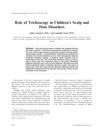A Study of Clinical and Dermoscopic Features in Alopecia Areata at a Tertiary Referral Center
October 2020
in “
International Journal of Research in Dermatology
”

TLDR The study concluded that short vellus hair and yellow dots were the most common signs of alopecia areata, indicating disease activity and remission.
In 2020, a study was conducted at the Vydehi Institute of Medical Sciences and Research Center, Bengaluru, examining 150 patients with alopecia areata (AA), a common chronic inflammatory disease causing unpredictable non-scarring hair loss. The study used dermoscopy, a noninvasive method, to study the signs of AA. The study found that males (54.7%) were more affected than females (45.35%), with a mean age of 25 years. The most common type of AA was patchy alopecia (76%), and the most commonly affected site was the scalp (49.35%). Stress was a triggering factor in 24.70% of patients, and nail changes were seen in 20.7% of patients. Dermoscopic findings included yellow dots (80%), short vellus hair (74.7%), exclamation hair (34%), black dots (28%), and broken hair (25.3%). The study concluded that short vellus hair and yellow dots were the most common findings, and these varied according to the activity of the disease and treatment. Yellow dots, black dots, and tapering hair indicated active disease, while short vellus hairs indicated remission.



